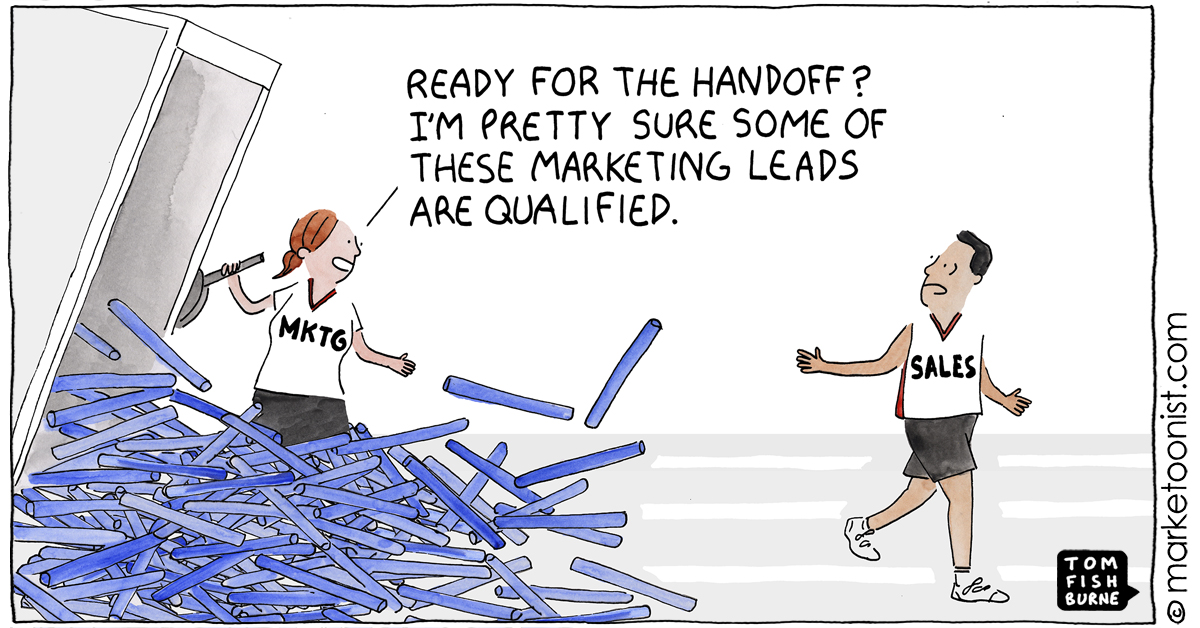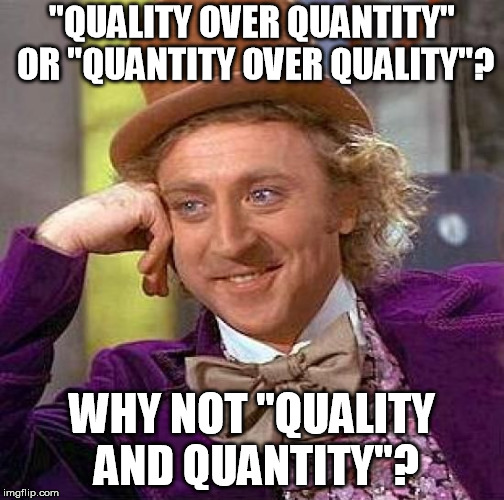The Ultimate Guide to Demand Generation
You don't have a business without demand for your product or service. Demand generation is a long-term play to grow your business by growing demand.
- Blog
In 2025, lead generation remains essential for every business. We explain the what, why, and how of inbound lead generation so you can get started.
Are you a marketer tasked with finding the business more leads? Or a sales leader needing to fill up the pipeline? Maybe you're a business owner wanting to build an engine that drives growth?
The goal is simple — you need inbound leads.

Source: thebrendans.wordpress.com
In this post, you’ll learn what makes a good inbound lead, the challenges of lead generation, and strategies you can start using today.
Let's dive in.
A lead is any person who indicates interest in a company's product or service in some way, shape, or form.
Here's a definition from Alex Hormozi who wrote $100m Leads:
“...a lead is a person you can contact. That’s all. If you bought a list of emails, those are leads. If you get contact information from a website or database, those are leads. The numbers in your phone are leads. People on the street are leads. If you can contact them, they are leads.”
But leads are not all created equal. A good inbound lead is, therefore, qualified and engaged buyer.
Inbound leads as the name suggests typically comes in through natural, self-directed actions as they are searching for a solution to a problem.
They find you instead of you chasing them.
Basically, there are two ways they get qualified in B2B:
💡Related post: How to define a lead, MQL, SQL and opportunity
 Source: marketoonist.com
Source: marketoonist.com
This is a typical journey of a potential buyer today:
Firstly, a buyer identifies a problem.
They start searching for a solution.
They come across your website on Google.
They follow you on LinkedIn, maybe Instagram too.
They start getting retargeted with your ads.
They download an eBook.
They subscribe to your newsletter.
They listen to your podcast.
They read a case study.
They book a meeting.
Can you identify these stages? (shoutout to the marketers! 👋)
This is the marketing funnel AKA buyer's journey.
Here it is visualised:

A lead becomes identifiable only at the conversion stage.
So, you need to be prepared at every stage of the funnel—attracting, engaging, and converting—to turn those leads into customers.
"Inbound lead generation attracts leads by engaging them with the right content at the right time, increasing the chance of conversion."
One of the common mistakes is thinking lead generation is all about the numbers.
On the one hand, it is about the numbers.
But on the other, numbers are not everything.
B2B marketers like us love tracking the numbers don't we?
Some popular metrics include:
Lead volume: the number of leads generated
Conversion rates: the number of leads that convert into customers
ROI: return on investment
ROAS: return on ad spend
Metrics like the number of leads, conversion rates, and ROI are key signs of how well you're doing. So, track them? Absolutely.
But concentrating solely on the numbers can be somewhat misleading and may not provide a complete picture of your lead generation efforts.
Fact 1: Lead generation is about the numbers
The more leads you have, the higher the probability of converting some of them into paying customers. This is a fundamental aspect of any lead generation strategy.
But, it's not just about sheer volume.
Fact 2: Quality matters just as much, if not more, than quantity
A smaller number of highly qualified leads can be far more valuable than a large number of unqualified ones.
So it's a little bit of both really.
Inbound lead generation is like dating for businesses — it's all about building relationships and wooing potential buyers through their buyer's journey. You want as many of them to come through the door, but you also want to have the right ones come through.
So, although numbers do matter, they aren't everything.
Finding the right balance between quantity and quality, and focusing on building relationships and engaging with customers, is the secret sauce to a winning inbound lead generation strategy. 😉

Source: imgflip.com
Lead generation isn't just for startups.
Regardless of your business's current stage, growth is unattainable without new leads.

Startup: At this exciting early stage, businesses are just starting to make their mark in the market. Lead generation efforts are all about spreading the word and attracting those first enthusiastic supporters.
Growth: As your business begins to pick up steam, it's time to ramp up those lead generation efforts. This stage is all about fine-tuning and enhancing your strategies to draw in a bigger crowd.
Maturity: At this stage, your business has made a name for itself and built a loyal customer base. Lead generation strategies at this stage focus on keeping the momentum going and ensuring your customers stick around.
Decline: When your business hits a rough patch, like market saturation or shifting customer preferences, it's time to shake things up! Revitalise your lead generation efforts by rebranding, launching new products or services, or pivoting to meet new market demands.
While inbound lead generation is an evergreen marketing strategy, it's not a magic fix for sudden drops in sales or revenue.
Let's take a look at some of the pros and cons:
Pros:Cost-effective: Inbound leads come to you naturally, basically "freely."
Higher quality: Leads are often more qualified and ready to engage.
Trust is earned: You're constantly giving so you build goodwill.
Sustainable over long-term: Compared to other strategies, this continues working once it's set up and maintained.
Sales might take a while: Outbound might see quicker results than inbound.
Requires consistent effort: Lead generation require regular updates and engagement.
Initial slow growth: It takes time to establish the system before it operates efficiently.
Hard to measure: Measuring effectiveness can be challenging without the right tools.
Heavy reliance on digital channels: Strongly dependent on digital platforms, which can change and are not owned.
The only thing you need to understand about strategy is this:
Strategy is NOT tactics.
Your lead generation strategy involves 3 things — knowing your audience, crafting a content strategy and maximising reach through distribution. Every business is different so we are sharing some generalised ideas below with some examples to hopefully give you an idea of what to aim for.
First things first, get to know your audience. You may start by building detailed buyer profiles that cover things like:
This is a good starting point, but — they are assumptions. The best way to learn about your customers is to ask them directly. Don't guess—have real conversations.
Buyer Calls: Get on calls with potential or current customers and ask about their needs, decision-making process, and what they care about most. Ask simple questions like:
Post-Purchase Interviews: After someone buys from you, ask them what made them choose your product, what hesitations they had, and how you can improve. This helps you fine-tune your strategy.
From knowing your audience, you can now start to build up a content strategy to address their needs. Content should cater to every stage of the buyer's funnel.
Stage 1: TOF (Top of Funnel)
Buyers are still learning about their problems or needs. Content should be informative, focusing on education and building awareness without pushing a product or solution. They are starting to be aware of their problems.
Tactical examples:
Stage 2: MOF (Middle of funnel)
Buyers are aware of their problems and are exploring different solutions. Content should provide more in-depth information that helps them consider your product or service as a viable solution.
Tactical examples:
Stage 3: BOF (Bottom of funnel)
Buyers are on the verge of making a decision and are weighing your solution against others. Your content should highlight why your product or service is the top choice, giving them that final nudge of confidence.
Tactical examples:
Once you've created your content, the next step is to make sure it reaches the right audience. Distribution is key.
You’ll want to use different channels to share and promote your content. Think of it like casting a wide net—you want to get your message in front of as many people as possible, but also make sure it’s reaching the right people.
Here are some simple ways to do that:
SEO (Search Engine Optimisation): This is about making sure your content appears when people search for topics related to your business. Start by doing some keyword research to figure out what your audience is searching for (e.g., using tools like Google Keyword Planner). Then, optimise your content by including those keywords naturally, and make sure your website is well-structured.
Social media: Social media is a great way to share your content and interact with your audience. Everyone uses at least one social platform. Share helpful posts on platforms like LinkedIn or Instagram. Engage in conversations—comment on industry trends or respond to your followers. You can even use paid ads to reach more people (e.g., promoting a recent blog post or case study to a wider audience).
Email marketing: Send targeted, personalised emails to nurture your leads. For example, if someone downloads a guide from your website, follow up with a helpful email sharing additional tips or resources. Send weekly or monthly newsletters with thought leadership content. Make sure your emails speak directly to the needs of your audience to keep them engaged.
Inbound lead generation is like planting a garden. It sounds simple—just plant seeds and water them—but in practice, it requires patience, the right conditions, and constant nurturing to see those seeds grow into something fruitful.
Reach out to us if you want to start your lead generation at any stage of your business. We always start with strategy, so when you're ready just book a chat with us at this link:
Learn more about B2B marketing and HubSpot.
Samuel is a Digital Marketing Specialist with Content Chemistry, a digital marketing agency and a HubSpot Solutions Partner and Google Partner based in Sydney. He is enthusiastic about good coffee, Malaysian food and watching movies.